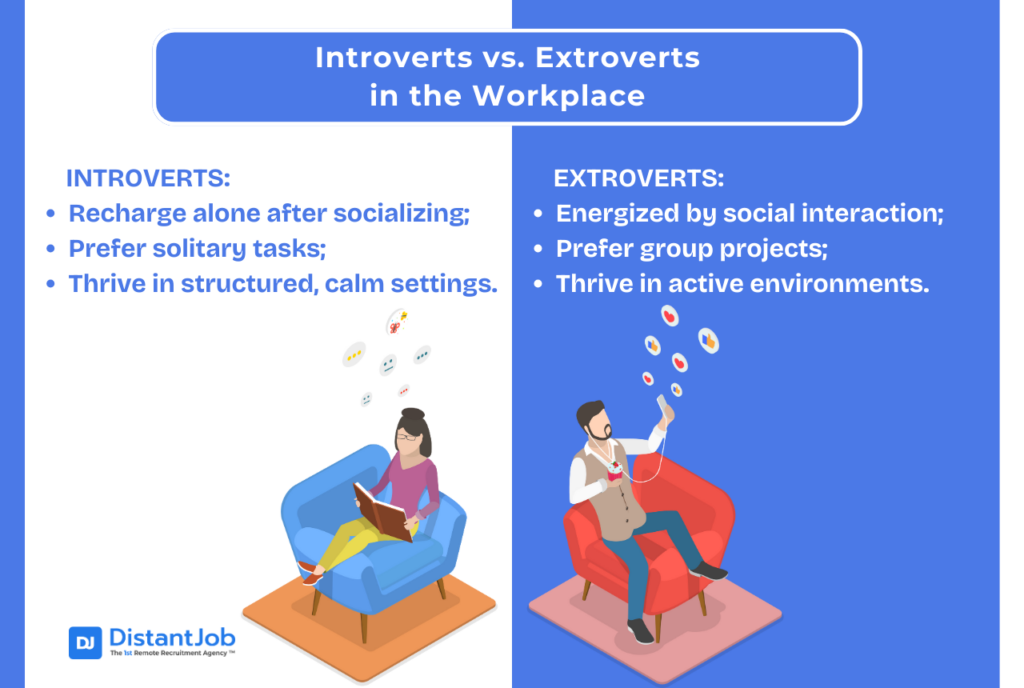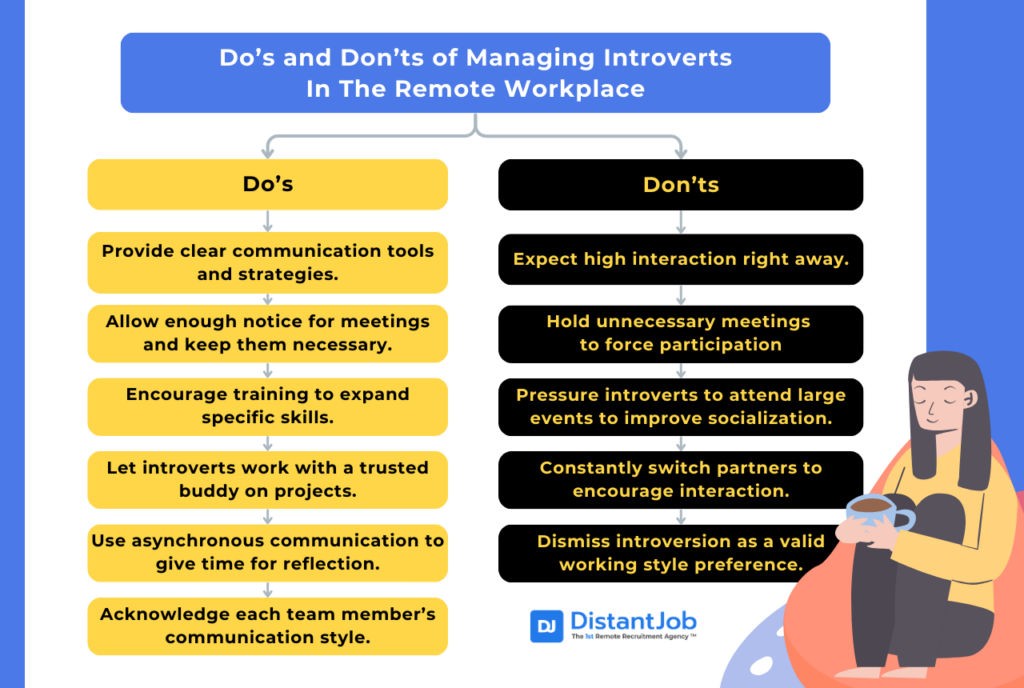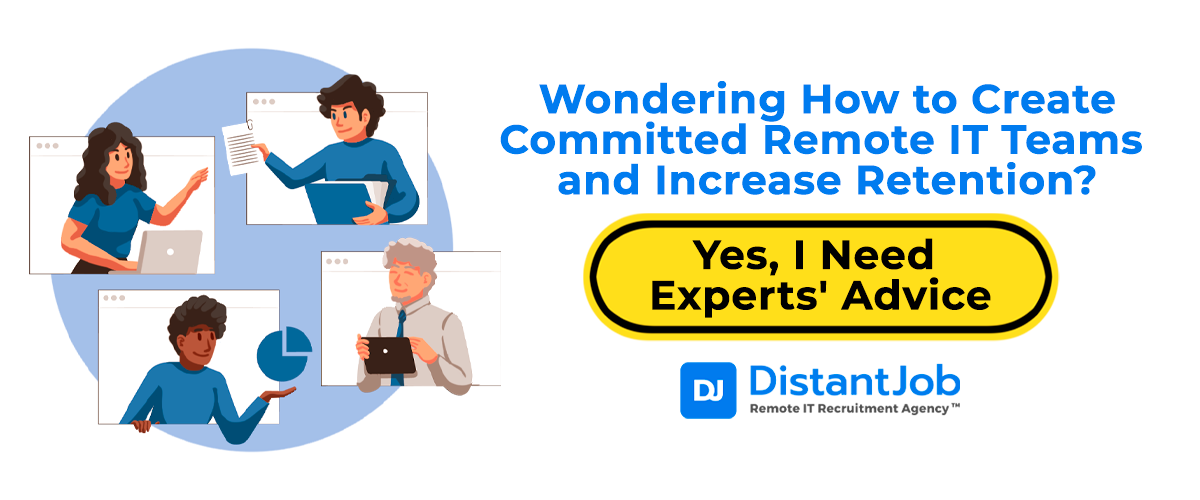Have you ever heard of the so-called ‘introvert personalities’? We all have that type of friend. The one who never hangs out on Friday and goes to parties to hide in the coat closet. If you didn’t get it so far, it’s another name to talk about introverts in the workplace. They are great and reliable friends. The best ones to have a peaceful conversation over eggs benedict and enjoy actual Netflix and Chill. However, engaging introverts in a remote workplace can be challenging.
On the surface, remote work might suit an introverted personality perfectly. You can participate in meetings from a distance, rely on asynchronous communication, and work independently on tasks. However, this isn’t always the case.
According to Virginia research firm Greater Divide’s survey, extroverts are less likely to experience mental health issues due to quarantine and remote work than introverts. In the same vein, Tribe’s research shows that 13% of introverts would prefer to return to the office after the pandemic. Likewise, 30% find it harder to build connections with co-workers working from home.
The real question isn’t which personality is better suited for remote work, but how to find effective strategies for engaging introverts in a global, virtual workplace.
So, how can you ensure introverts stay involved and get the support they need in these settings?
In this article, we’ll look into the special strengths introverts bring to the online workplace, the obstacles they face, and how managers can create a welcoming environment that helps them do well in global remote teams.
What Does it Mean to be an Introvert, aka a Wallflower Person?
Introverts are sometimes referred to as wallflowers. And according to the Urban Dictionary, a wallflower is one who hides at parties and tends to be reserved when surrounded by many people. This type of personality can come across as socially awkward. Simply, they prefer to spend time with a few, selected, people and never try to get too much attention.
The Oxford Dictionary, rather than saying ‘they hate parties,’ defines an introvert as someone generally more concerned with intimate thoughts and feelings than external things. In the 20s, psychologist Carl Jung introduced the terms introversion and extroversion to identify two different types of personality. After that, this distinction became the core of theories on personality types like the Myers-Briggs Type Indicator (MBTI). Most of these theories recognize a certain degree of both opposites in each of us. However, people often act based on one of these two types of personality.
Introverts tend to be quiet, introspective, and independent. While extroverts gain energy from social interactions, introverts feel drained by extended socializing and need alone time to recharge.
Common traits of introverts are:
- Independence
- Self-awareness
- Quietness
- Rising energy when dealing with ideas
- Solitary activities
- Smaller social circle
- Observe situations clearly and objectively.
Introverts vs. Extroverts in the Workplace

While we’ve already touched on the differences between introverts and extroverts, there are more nuances in how these two personalities approach their work. Introverts tend to thrive in focused, quiet environments, often preferring written communication and solitary tasks. Extroverts, by contrast, flourish in dynamic, social settings and are energized by verbal collaboration.
To better understand the differences between introverts and extroverts in the workplace, here’s a comparison table that highlights how these two personalities interact, communicate, and work within teams.
| Introverts | Extroverts |
| Recharge alone after socializing | Energized by social interaction |
| Prefer solitary tasks | Prefer group projects |
| Thrive in structured, calm settings | Thrive in spontaneous, active environments |
To manage both types, balance team dynamics with flexible communication styles and work environments, allowing introverts to recharge and extroverts to collaborate effectively.
What Makes Introverts So Great In The Remote Workplace?
Unlike extroverts, the strength of introverts lies in their ability to analyze and reflect on what’s being said. As a result, if you get an answer from them, it is generally well thought out and an excellent contribution to the conversation. That’s the first benefit of introverts in the workplace.
As Forbes states:
“Introverts have a wealth of natural strengths — they assess situations before acting, they listen to the ideas of others, and they are skilled at taking independent action.”
In remote and international teams, introverted personalities are usually the best ones in planning schedules and tasks. As attentive observers of others, they quickly understand how to pair team members and distribute tasks according to anyone’s skill set.
Introverts usually like to prepare things ahead and leave enough time for unplanned scenarios. So, you can benefit from their talent to organize your teamwork. And leave extroverts dealing with everything that relates to socialization or meeting many people at once.
Also, since they typically prefer quieter environments and minimal real-time interactions, they excel at asynchronous communication. They thrive when given the space to focus and respond thoughtfully without the pressure of constant calls or meetings. This makes them particularly adept at collaborating across different time zones, where asynchronous work is necessary. Their ability to process information and contribute in a well-organized manner helps keep global projects on track, ensuring smooth communication between remote team members despite varying schedules and locations.
Finally, introverts might not speak much , but it doesn’t mean they aren’t carefully observing. Their ability to focus enables them to keep track of meetings and deliver precise reports, especially in an international setting where clear communication is essential for cross-cultural collaboration. For example, introverts are great at preparing detailed reports, while extroverts can use those insights to present to clients and engage an audience.
You can use both personalities to achieve the best performance for your company. Being a team player is essential for both types of characters. And if you make them work together, they will both contribute to your project. So, engage in teamwork and casual conversation. However, in the case of introverts, remember that significant social interactions will be more natural with some notice!
How to Understand and Engage With Introverted Members of Your Remote Team
- Never accept introversion as an excuse
- Don’t put introverts under the spotlight
- Identify the type of introvert you are working with
The first step to engaging and managing introverts in the workplace is ensuring introversion isn’t used as an excuse for non-participation. It’s OK to leave time to those who are shy or prefer to think about their intervention. However, it can’t turn into a pattern in which only extroverts lead the way while the rest lie on the back. Since, while it’s essential to allow time for reflection, all team members, including introverts, need to contribute equally. And, in that sense, managing introverts effectively means giving them space to process and participate without pressure.
A second step is to organize a fair working schedule for everyone. You don’t need to constantly put introverts under the spotlight (you will get the opposite result!). The point is to ensure a suitable space to contribute to for everyone. In virtual settings, regular video meetings are necessary to keep team members up to date on progress and goals. During these meetings, create breaks in the discussion to ensure the right balance among all team members. Or you can use humor to chill the atmosphere and play with each personality trait while calling for feedback.
Also, take into consideration and use to your advantage the benefit of asynchronous communication, as it helps introverts thrive, especially when working across different time zones and communication styles in international teams.
Finally, understand the various types of introverts on your team to manage and engage them successfully. That’s right. All introverts have their own way of avoiding people. So, make sure to identify and share different workstyles to combine them in your favor. If you know the skill-set and personality of your team members, you can organize your workflow so that anyone feels comfortable giving you the best results they can.
Let’s examine the different types of introverted personalities and how to engage with and manage each one.
Different Types of Introverts and their Characteristics
Remember when we mentioned that Carl Jung introduced the concepts of introversion and extroversion in the 1920s? Since then, researchers have expanded on these terms, identifying unique traits within introversion itself.
In 2011, psychologists Jennifer Grimes, Jonathan Cheek, and Julie Norem found and categorized four main types of introversion: social introvert, thinking introvert, anxious introvert, and restrained introvert.
1. Social Introvert
Social introverts like occasional gatherings with family or friends but value alone time more than anything else. As psychotherapist Anthony Freire states: “A social introvert doesn’t avoid crowds because of anxiety but rather [because of] their preference. Where they feel the most comfortable and happy is either incomplete solitude or in small groups in more subdued places.”
Common traits and habits of social introverts:
- Preference for intimate gatherings
- Regular solo date or vacation
- Need for alone time to recharge – especially in a relationship
- Unlikely to attend large social events but won’t oppose invitations
Working with and managing social introverts remotely:
Social introverts thrive in small groups and prefer independent tasks. To engage them effectively, managers should offer a balance between collaboration and solo work. This approach ensures they can participate without feeling overwhelmed.
Clear communication is key. Allow social introverts time to process information and contribute in their own thoughtful manner. Regular, smaller meetings encourage them to open up, offering valuable insights.
When managed well, their punctuality, precision, and deep thinking can greatly enhance the team’s productivity and cohesion.
2. Thinking Introvert
As clinical psychologist Carla Marie Manly, Ph.D., explains: “The thinking introvert is very cognitive by nature. Often intellectual, this type of introvert is often at peace when studying, reading, learning, researching, and investigating.”
Thinking introverts carefully consider their answers – “Let me think about that” is one of their most common answers. They are great listeners, and their introversion helps them find the best way to deal with people and their problems.
Common traits and habits of thinking introverts:
- Introspection
- Preference for activities such as studying, reading, researching, or other creative activities
- High self-awareness and deep reflection
Working with and managing thinking introverts remotely:
Thinking introverts excel at tasks that require deep reflection and analysis. To engage them, provide projects that involve research or independent problem-solving. Their intellectual approach and high self-awareness make them valuable for strategic decision-making.
Collaboration in international teams benefits from their thoughtful input. Allow them time to process ideas and contribute detailed feedback. In discussions, they are great moderators, offering alternative perspectives and solutions that might not be immediately obvious.
Managing thinking introverts involves respecting their need for quiet time to reflect, which leads to well-informed and creative outcomes.
3. Anxious Introvert
This type of introvert usually shies away from other people and may appear agitated or on edge. They can be painfully shy in public and often battle with feeling self-conscious of their perceived lack of social skills. Anxious introverts do not like attention drawn to them and embrace the phrase ‘wallflower.’ The high defense mechanism and the scientific attempt to avoid others make them rude (very directly) in social situations. They give their best in their comfort zone and struggle to adapt to changes or new people.
Common traits and habits of anxious introverts:
- Typically nervous in most situations
- Highly avoidant and rude behavior
- Strong discomfort with social interaction
Working with and managing anxious introverts remotely:
Anxious introverts often struggle with social interactions, which can cause discomfort or nervousness. To engage them effectively, start by creating a safe environment where they feel comfortable. Pairing them with a trusted team member helps them gradually open up and contribute without feeling overwhelmed.
Flexibility is key when managing anxious introverts in global teams. Use asynchronous communication to reduce stress and allow them to respond thoughtfully. Setting clear expectations helps them feel more in control and less anxious about tasks or deadlines.
Managing anxious introverts requires patience and understanding. Give them time to adjust to new people or situations, and always provide clear communication to reduce anxiety. When they feel safe, they can contribute valuable insights to the team.
4. Restrained Introvert
The restrained introvert, or the inhibited introvert, is more reserved and highly values personal space. Instead of being shy or avoidant, this personality comes across as thoughtful and grounded. They methodically analyze any situation and person, building trust before opening up to others.
As Manly explains: “the restrained introvert tends to be reflective and even plodding in nature. Often unemotional, this type of introvert is often very controlled and may have very grounded energy. […] The restrained-type introvert is often the quiet, dutiful person that others tend to rely on.”
Common traits and habits of restrained introverts:
- A slow and systematic approach to things
- Preference for predictable activities
- Sometimes unemotional and calculator
Working with and managing restrained introverts remotely:
Restrained introverts are thoughtful, methodical, and prefer to build trust before fully engaging with others. To engage them effectively, offer tasks that allow for deep, focused work. They thrive in environments where they can methodically analyze situations, making them reliable for long-term projects.
Trust is key for restrained introverts. In remote and global teams, give them time to adjust to team dynamics, especially across different time zones. Their grounded approach ensures steady progress without the need for frequent check-ins.
Managing restrained introverts involves respecting their personal space and allowing them to work at their own pace. Once trust is established, their loyalty and consistency can greatly benefit team cohesion and long-term success.
Do’s and Don’ts of Managing Introverts In The Remote Workplace
How do I know if my employees are introverts? Well, if one of your team members isn’t very talkative and takes more time to integrate, chances are, you have an introvert.
However, working with an introvert, aka a wallflower personality, doesn’t mean working with a hermit, someone disengaged. You just need to find creative strategies to increase your introverts’ engagement and encourage them to speak.
In global teams, that means encouraging asynchronous communication as it allows introverts to process information at their own pace, ensuring they can contribute thoughtfully without the pressure of immediate response.
To recap, here are some dos and don’t to engage introverts in a virtual workplace:

Introverts in Leadership Roles
Many people think introverts can’t lead well. They believe leaders need to be the loudest or most pushy. But this isn’t true. Introverts bring a lot of value—to remote and global teams. They think about problems, which often leads to better choices. This skill to stop, think, and process info helps when leading teams across different time zones and cultures.
Introverts also shine at building deep personal bonds. As leaders, this talent helps them create stronger connections with team members. Introverted leaders listen more than they talk, which allows them to grasp their team’s needs on a deeper level. In a remote setup where team bonding often proves tougher, this is a plus. With their steady and stable presence, introverts earn trust over time creating an atmosphere where teamwork flourishes without the need to be the loudest voice.
How Can Introverts Lead Effectively in Remote and International Teams?
The thing is, introverts don’t rush into decisions. Instead, they take the time to think things through, which matters when you’re in charge of a team spread across different areas. Unlike your typical bosses who might lean on snap judgments and endless meetings, introverts shine in one-on-one talks making team members feel like someone’s listening to them. This thoughtful way of doing things doesn’t just build stronger connections – it also makes sure decisions are based on solid info and take into account different cultural views.
Also introverted leaders can have a positive impact on managing global teams by creating structured environments. They can set up clear communication rules, define expectations for response times, and even use asynchronous communication when needed. This approach ensures that everyone stays informed, and introverts can continue to lead without feeling pressured to respond immediately.
Leveraging Introvert Strengths in Leadership
So, how can introverts leverage their strengths in leadership? For starters, they listen well. They don’t talk over others. Instead, they watch and take in all the details before they speak up. This means their input carries more weight and makes more sense. In fact quiet leaders often give their team members a boost by hearing them out and offering advice that fits what the team needs. By giving each person attention, they can smooth over disagreements and help everyone work together better.
Another strength of introverts lies in their steady nature. Introverts may not grab all the attention, but their dependable and consistent approach creates trust among team members. They steer clear of the extreme ups and downs often linked to extroverted leadership styles, which brings stability. This cool and collected attitude helps cut down on the mess that can pop up in remote work setups where team members might feel cut off from each other.
Ways for Introverts to Tackle Leadership Challenges in Global Teams
Now, leading global teams can feel overwhelming for anyone, but introverts have their own set of strengths to navigate these challenges. For instance, it’s important for introverted leaders to set boundaries to protect their energy. A series of consecutive meetings can exhaust them, so it’s crucial to space them out and plan quiet periods to reflect. Introverts should give priority to asynchronous communication when possible, which enables them—and their team—to add input on their own schedule.
Here are some practical tips that introverted leaders can use when managing global teams to sustain their energy and promote effective communication:
- Make communication rules clear: Let team members know when they should expect answers and which channels they should use.
- Use asynchronous tools: This keeps everyone in the loop even across different time zones, without the stress of having to respond right away.
- Balance meetings with downtime: Protect energy by spacing out meetings and scheduling quiet reflection periods.
By staying true to their quiet nature and focusing on well-thought-out communication, introverts or “wallflowers” can overcome leadership hurdles and do well in remote and international settings.
Understanding Your Remote Team’s Personality
When you take the time to truly understand how to communicate effectively with your remote team members, you’re laying the groundwork for long-term success. Going the extra mile to identify the unique needs of each personality type, especially introverts, means you’ll see greater engagement and productivity. Supporting introverts isn’t a challenge—it’s an opportunity to bring valuable insights and depth to your team.
And remember, understanding your team members’ personalities is the key to a successful hiring process. If you know that your team will benefit from a grounded and calm nature, you seek an introvert. When you need someone passionate and able to convince anyone about a project, you want an extrovert. Both personality types are great, but you need to know what your team needs.
At DistantJob, we understand that building a successful remote team goes beyond just skills—it’s about finding the right personality fit. Whether you need an introvert’s thoughtful insight or an extrovert’s dynamic energy, we help you hire the perfect match to complement your team culture. With over a decade of expertise in remote IT hiring, we know how to find talent that brings long-term value. Ready to build your dream remote team? Reach out to us today, and let’s make it happen!





